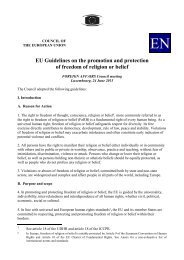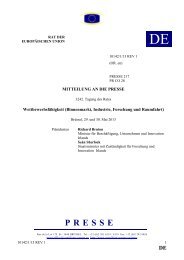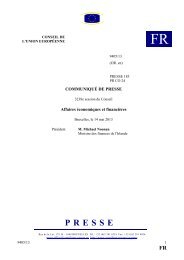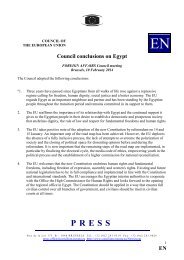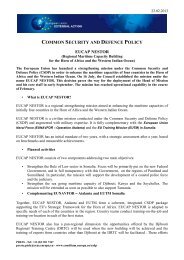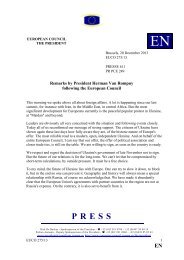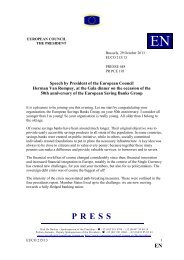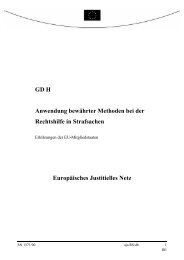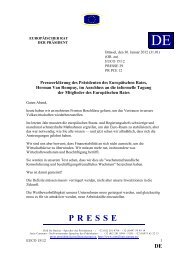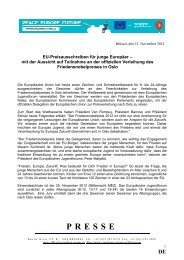14508/09 ADD 1 PL/vk 1 DG G COUNCIL OF THE ... - Europa
14508/09 ADD 1 PL/vk 1 DG G COUNCIL OF THE ... - Europa
14508/09 ADD 1 PL/vk 1 DG G COUNCIL OF THE ... - Europa
You also want an ePaper? Increase the reach of your titles
YUMPU automatically turns print PDFs into web optimized ePapers that Google loves.
men. As a result this ‘new’ institution has also become male dominated. Other examples are the EU<br />
battle groups, multilateral rapid deployment units staffed and organised by different MS but<br />
operating under the EU flag. One example is the Nordic Battle Group (NBG), the EU Battle Group<br />
on standby during the first half of 2008 and led by Sweden’s armed forces. In the NBG, gender<br />
issues were taken seriously from the start. It included gender training and a gender advisor who was<br />
directly responsible to the top commander. The ambition was to recruit around 20 % of women,<br />
even so, in the end only 5 % of the NBG force were women (Kronsell forthcoming).<br />
It is notable that the majority of MS' responses to UNECE questions make no mention of the EU<br />
indicators on women in armed conflict nor do they acknowledge the data and considerations<br />
provided by the MS for the French Presidency’s survey (2008). Only the French report makes<br />
explicit reference to the indicators that have been developed.<br />
Feminists and gender researchers argue (e.g. Reardon 1996; Cockburn 2004) that there is a<br />
continuum of violence that connects the violence against women in the home with patriarchy and<br />
with the institutions of war, i.e. the military. An example is that when soldiers return home from<br />
war with post traumatic stress, they tend to take out their anger and frustration through violence,<br />
often directed toward women and children in the family. There is ample research in the US showing<br />
this (e.g. Committee on Gulf War and Health 2008). In the 1990s there was a war in Europe;<br />
soldiers from the MS were part of the coalition forces in the war in Iraq, and many have been<br />
deployed in international missions in the Balkans, on the African continent and in Afghanistan.<br />
They have experienced violence, and, when they return home, many may suffer from post traumatic<br />
stress. The connection between violence against women and men’s and women’s different and<br />
separate experience of armed conflict, war and the armed forces is not raised in the MS' reports to<br />
the UNECE.<br />
The connection between military activities and prostitution has been widely documented<br />
(Enloe 2007). UN SCR 1325 and 1820 are a response to the scandal and problem of abuse of<br />
women and children through prostitution around peacekeeping missions. Armed forces stationed<br />
abroad and peacekeeping missions (Higate 2004) seem to play an important role in generating<br />
trafficking in women and children for sexual purposes.<br />
<strong>14508</strong>/<strong>09</strong> <strong>ADD</strong> 1 <strong>PL</strong>/<strong>vk</strong> 81<br />
ANNEX <strong>DG</strong> G EN



